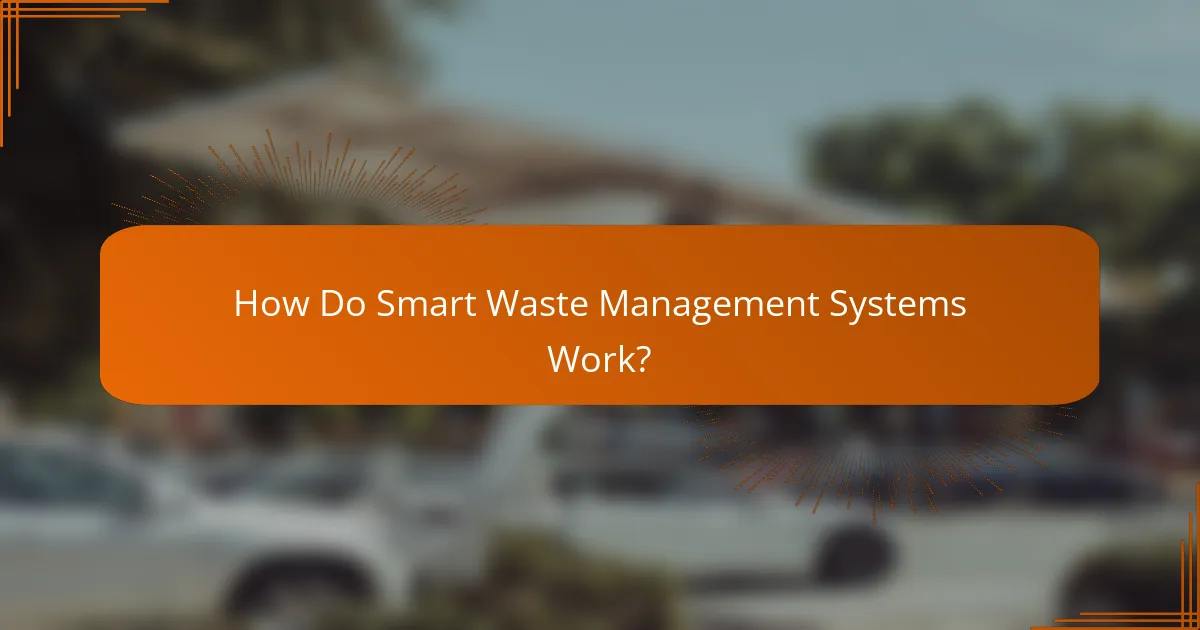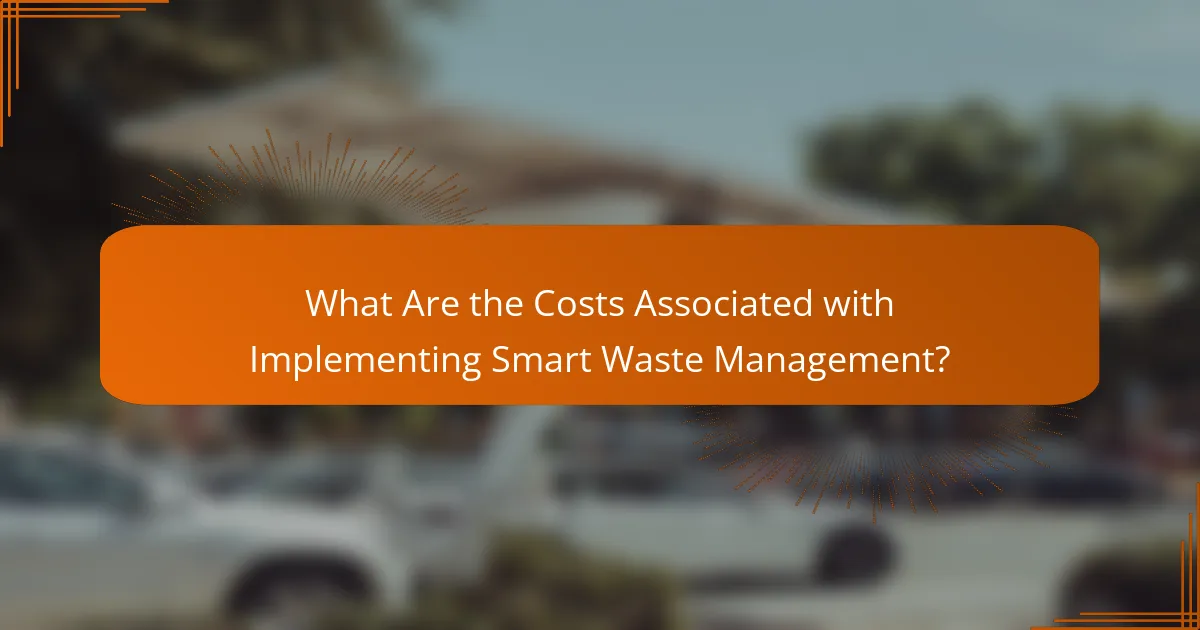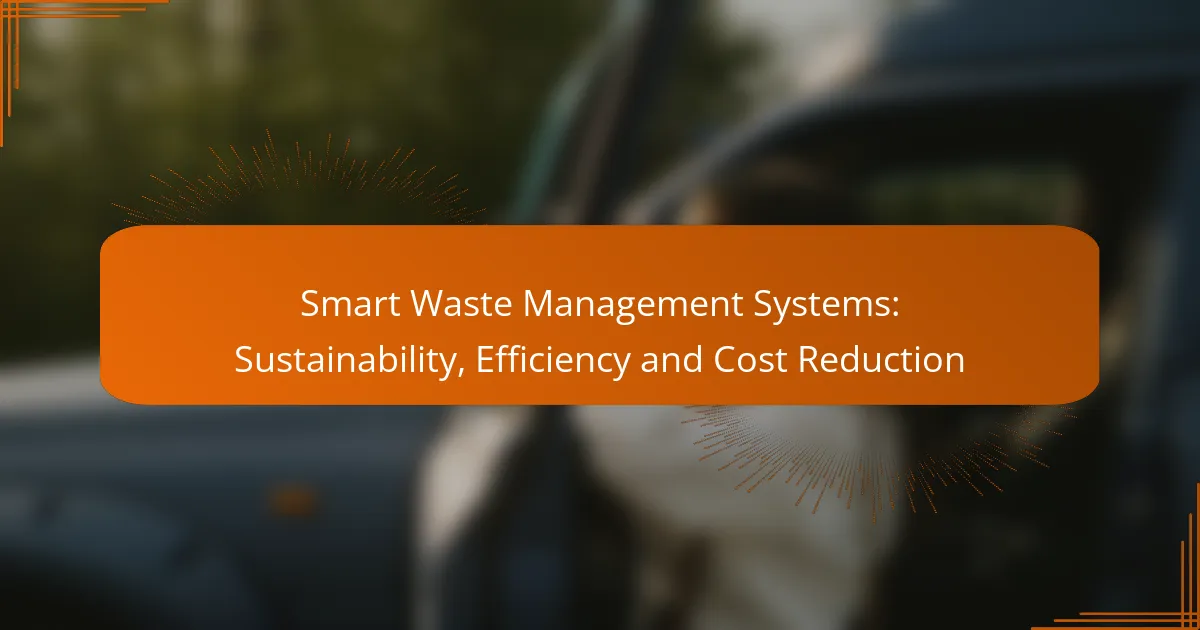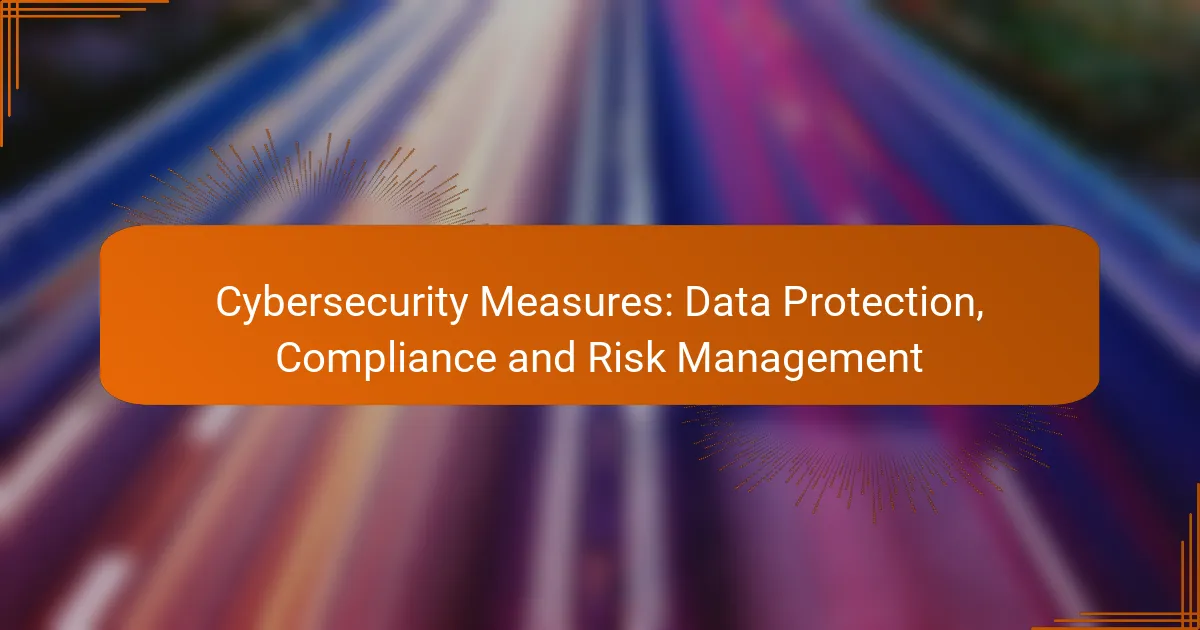Smart waste management systems revolutionize the way we handle waste by integrating advanced technologies to enhance sustainability, efficiency, and cost-effectiveness. By utilizing IoT sensors, AI analytics, and real-time monitoring, these systems streamline waste collection and processing, leading to improved resource management and reduced environmental impact.

What Are the Key Benefits of Smart Waste Management Systems?
Smart waste management systems offer significant advantages, including enhanced sustainability, reduced costs, and improved operational efficiency. By leveraging technology, these systems optimize waste collection and processing, leading to better resource management and environmental outcomes.
Sustainability improvements
Smart waste management systems contribute to sustainability by minimizing landfill use and promoting recycling. They utilize sensors and data analytics to monitor waste levels, ensuring that recyclable materials are collected efficiently and diverted from landfills.
For example, cities implementing smart bins can increase recycling rates by up to 30%, as these bins signal when they are full, allowing for timely collection and reducing overflow. This proactive approach helps conserve resources and lowers carbon footprints.
Cost reduction strategies
Implementing smart waste management can lead to significant cost savings for municipalities and businesses. By optimizing collection routes and schedules based on real-time data, organizations can reduce fuel consumption and labor costs.
For instance, cities can save tens of thousands of dollars annually by decreasing the number of collection trips needed. Additionally, reduced landfill fees from improved recycling rates further contribute to overall cost reductions.
Efficiency enhancements
Smart waste management systems enhance operational efficiency by automating processes and providing real-time insights. This technology allows for better resource allocation, ensuring that waste collection is performed only when necessary.
For example, using GPS tracking and route optimization software can reduce collection times by 20-30%, allowing waste management teams to focus on other critical tasks. This streamlined approach leads to faster response times and improved service delivery.
Data-driven decision making
Data-driven decision making is a cornerstone of smart waste management systems. By collecting and analyzing data on waste generation patterns, organizations can make informed choices regarding resource allocation and policy development.
For example, cities can identify peak waste generation times and adjust collection schedules accordingly, improving service efficiency. Additionally, data analytics can help in forecasting future waste trends, allowing for proactive planning and investment in infrastructure.

How Do Smart Waste Management Systems Work?
Smart waste management systems utilize advanced technologies to optimize waste collection and processing, enhancing sustainability and efficiency while reducing costs. These systems integrate real-time monitoring, data analytics, and automated scheduling to streamline operations and improve resource allocation.
Real-time monitoring technologies
Real-time monitoring technologies involve the use of sensors and IoT devices placed in waste bins to track fill levels and environmental conditions. These sensors send data to a central system, allowing waste management operators to monitor the status of waste containers continuously.
By employing these technologies, municipalities can reduce unnecessary collection trips, saving fuel and labor costs. For instance, a city might find that certain bins fill up faster during events, allowing them to adjust collection schedules accordingly.
Data analytics integration
Data analytics integration processes the information gathered from monitoring technologies to identify patterns and trends in waste generation. This analysis helps waste management companies make informed decisions about resource allocation and operational efficiency.
For example, analytics can reveal peak waste generation times, enabling companies to optimize collection routes and schedules. Utilizing predictive analytics can further enhance efficiency by anticipating future waste trends based on historical data.
Automated collection scheduling
Automated collection scheduling uses algorithms to determine the most efficient times and routes for waste collection based on real-time data. This system minimizes fuel consumption and labor costs by ensuring that collection vehicles only visit bins that require servicing.
By implementing automated scheduling, cities can achieve significant cost savings and reduce their carbon footprint. For instance, a municipality might implement a dynamic routing system that adjusts collection paths based on current fill levels, leading to more efficient operations overall.

What Are the Leading Smart Waste Management Technologies?
The leading smart waste management technologies include IoT sensors, AI-powered analytics, and mobile applications. These innovations enhance efficiency, sustainability, and cost reduction in waste management systems by providing real-time data and actionable insights.
IoT sensors
IoT sensors play a crucial role in smart waste management by monitoring waste levels in bins and containers. These sensors collect data on fill levels, temperature, and even odor, allowing for optimized collection routes and schedules.
For example, cities can deploy sensors in public trash bins to determine when they need to be emptied, reducing unnecessary pickups and fuel costs. This technology can lead to a decrease in operational expenses by up to 30% in some cases.
AI-powered analytics
AI-powered analytics process the data collected from IoT sensors to identify patterns and predict waste generation trends. This technology enables waste management companies to make informed decisions about resource allocation and operational efficiency.
By analyzing historical data, AI can forecast peak waste periods, allowing for better staffing and vehicle management. Implementing AI analytics can improve service delivery and reduce costs by optimizing routes and minimizing missed collections.
Mobile applications
Mobile applications facilitate communication between waste management companies and residents. These apps can provide users with information on collection schedules, recycling guidelines, and even report missed pickups.
For instance, residents can receive notifications when their waste is about to be collected, enhancing community engagement and compliance with waste disposal regulations. Additionally, these applications can streamline customer service by allowing users to submit requests or feedback directly through the app.

Which Companies Offer Smart Waste Management Solutions?
Several companies specialize in smart waste management solutions, providing innovative technologies to enhance sustainability, efficiency, and cost reduction. These companies utilize IoT sensors, data analytics, and automated systems to optimize waste collection and processing.
Bigbelly
Bigbelly is a leader in smart waste management, known for its solar-powered waste and recycling bins equipped with sensors. These bins monitor fill levels in real-time, allowing waste management teams to optimize collection routes and schedules, reducing operational costs and carbon emissions.
By using Bigbelly’s system, municipalities can achieve significant efficiency gains, often reducing collection frequency by up to 80%. This not only saves on fuel costs but also minimizes the environmental impact associated with waste collection.
Waste Management Inc.
Waste Management Inc. offers a comprehensive suite of smart waste solutions that leverage advanced technology to improve waste collection and recycling processes. Their services include smart bins and data analytics platforms that provide insights into waste generation patterns.
With Waste Management’s solutions, businesses can track waste disposal metrics, enabling them to implement more effective recycling programs. This approach can lead to increased recycling rates and lower landfill costs, aligning with sustainability goals.
Compology
Compology focuses on using camera technology to monitor dumpster fill levels and optimize waste collection schedules. Their system provides visual data that helps waste management companies make informed decisions about collection routes and frequency.
By adopting Compology’s smart monitoring solutions, organizations can reduce unnecessary pickups, leading to cost savings and improved operational efficiency. This technology is particularly beneficial for businesses with multiple locations, allowing centralized management of waste services.

What Are the Costs Associated with Implementing Smart Waste Management?
Implementing smart waste management systems involves various costs that can significantly impact budgets. Key expenses include initial setup costs, ongoing maintenance, and the potential return on investment.
Initial setup costs
Initial setup costs for smart waste management systems can vary widely based on the technology and scale of implementation. Typical expenses may range from a few thousand to several hundred thousand dollars, depending on factors like sensor installation, software development, and infrastructure upgrades.
When planning for these costs, consider the types of sensors, data analytics platforms, and integration with existing waste management systems. Investing in high-quality technology can lead to better long-term performance and efficiency.
Ongoing maintenance expenses
Ongoing maintenance expenses are crucial to ensure the smooth operation of smart waste management systems. These costs can include software updates, sensor replacements, and technical support, typically amounting to a few hundred to several thousand dollars annually.
Regular maintenance is essential to avoid system failures and ensure data accuracy. Budgeting for these expenses helps maintain system reliability and maximizes the benefits of the technology.
Return on investment analysis
Conducting a return on investment (ROI) analysis is vital to evaluate the financial benefits of smart waste management systems. An effective analysis should consider cost savings from improved efficiency, reduced labor costs, and lower landfill fees.
Many organizations report ROI within a few years, often achieving savings of 20-30% in waste management costs. To maximize ROI, focus on optimizing routes, reducing collection frequency, and leveraging data analytics for better decision-making.

What Criteria Should Be Considered When Choosing a Smart Waste Management System?
When selecting a smart waste management system, consider factors such as technology integration, scalability, cost-effectiveness, and user-friendliness. These criteria ensure that the system meets operational needs while promoting sustainability and efficiency.
Technology Integration
Technology integration is crucial for a smart waste management system as it determines how well the system can communicate with existing infrastructure. Look for systems that utilize IoT sensors, data analytics, and mobile applications to provide real-time monitoring and reporting. Effective integration can streamline operations and enhance decision-making.
Scalability
Scalability allows a waste management system to grow with your needs. Choose a system that can easily expand its capabilities, whether by adding more sensors or integrating with additional software. This flexibility is essential for adapting to changing waste volumes and regulatory requirements.
Cost-Effectiveness
Cost-effectiveness is a key consideration when evaluating smart waste management systems. Assess both initial investment and ongoing operational costs, including maintenance and software updates. A system that reduces waste collection frequency or optimizes routes can lead to significant savings over time.
User-Friendliness
A user-friendly interface is vital for ensuring that staff can effectively operate the smart waste management system. Look for systems with intuitive dashboards and easy-to-navigate features. Training time and user adoption rates can significantly impact the overall success of the implementation.



